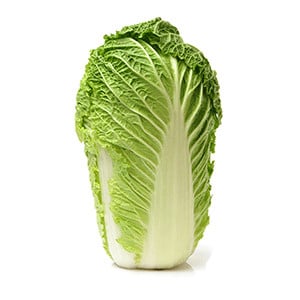Napa cabbage / Chinese cabbage

Napa cabbage / Chinese cabbage
Brassica rapa subsp. pekinensis
Plant family
Crucifers (Brassicaceae)
Also known as
Chinese Leaf, Winter Cabbage
Cultivation Break
3 Years
Season Overview
Propagating
Planting
Harvest
Harvest
J
F
M
A
M
J
J
A
S
O
N
D
1ST YEAR
2ND YEAR
Details
Light requirement
Semi-shaded
Water requirement
Moist
Soil
Medium (loamy)
Nutrient requirement
High
Dark germinator
Germination temperature
15 - 18 °C (Degrees Celsius)
Plant distance
40 cm
Row spacing
60 cm
Seeding depth
1.5 cm
Instructions
The season for this plant is over. The following instructions are for the next season.
Mid of April
Sowing
Beginning of May
Hoeing
Every two Weeks
Mid of July
Harvesting
Description
Chinese cabbage - also called Peking cabbage, Japanese cabbage or celery cabbage - is a vegetable plant from the cabbage family. Chinese cabbage forms a firm, oval to narrow cylindrical head weighing about 1-3 kg. Its leaves are mostly yellow-green and have broad, white, slightly curled leaf veins.
Origin:
China
Growing tips
Chinese cabbage needs deep, loose and nutrient-rich soil. The location should be sunny to semi-shady, and Chinese cabbage also loves wind-protected locations. Unlike other vegetables, it also thrives very well in cooler weather. It is a heavy grower and requires a lot of water. However, take care to avoid waterlogging. This type of cabbage grows best in a temperate climate where humidity is consistently high. As with all cabbages, you should give Chinese cabbage a growing break of 2 to 3 years.
Companion Plants
Bean ((Scarlet) runner bean)
Bean (Broad bean / Faba bean / Field bean)
Bean (Dwarf bean)
Bean (Hyacinth bean / Lablab-bean)
Bean (Lima Bean)
Bean (Runner bean)
Borage
Carrots
Celery (Celeriac / Celery root)
Celery (Celery)
Chard
Coriander / Cilantro
Dill
Leeks
Lettuce (Common chicory)
Lettuce (Endive / Escarole / Erisée)
Lettuce (Lamb's lettuce)
Lettuce (Lettuce)
Lettuce (Puntarelle / Cicoria di catalogna / Cicoria asparago)
Lettuce (Radicchio / Italian chicory)
Lettuce (Sugar loaf)
Pea
Soybean
Spinach (Summer)
Spinach (Winter)
Antagonistic Plants
Abessinischer Kohl / Äthiopischer Senf
Arugula / Rocket
Broccoli
Broccoli raab / Stem cabbage / Cima di rapa
Brussels sprouts
Cabbage (Cabbage)
Cabbage (Pointed cabbage)
Cabbage (red cabbage)
Cabbage (Savoy cabbage)
Cauliflower
Chives
Collard greens
Collard greens (Kale)
Collard greens (Tuscan kale / Dinosaur kale / Palm tree kale)
Fennel
Florence fennel / Finocchio
Garlic
Gemüsekohl - Flower Sprouts / Kohlröschen
Gemüsekohl - Futterkohl
Gemüsekohl - Kai-Lan / Chinesischer Brokkoli
Gemüsekohl - Rippenkohl / Portugiesischer Kohl
Gemüsekohl - Wildkohl / Urkohl
Jerusalem artichoke / Topinambur
Kohlrabi / German turnip / Turnip cabbage
Lovage
Marjoram
Meerkohle
Mizuna / Japanese mustard greens
Mustard
Onion
Onion (Spring onion)
Pak Choi
Raps
Raps - Scheerkohl / Sibirischer Kohl
Rübsen - Ölrübsen
Rübsen - Wilde Rübsen
Rutabaga / Swedish turnip
Turnip
Diseases
Angular leaf spot of cucumber
Root Rot
Downy mildew
Powdery mildews
Club root of cabbage
Pests
Cutworms
Land snails
Aphids
Cabbage white
Flea beetles
Cabbage fly
Nematodes
White fly